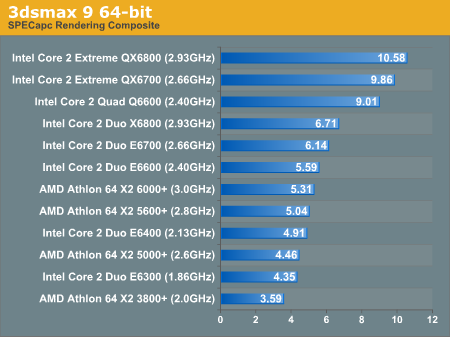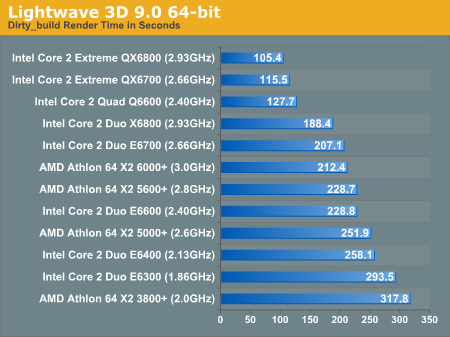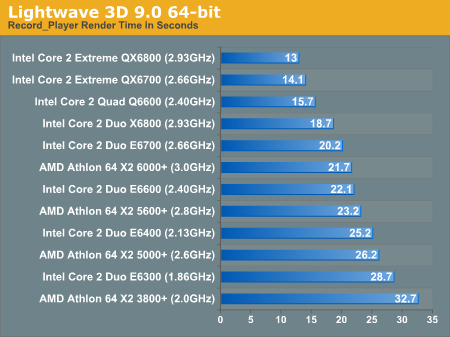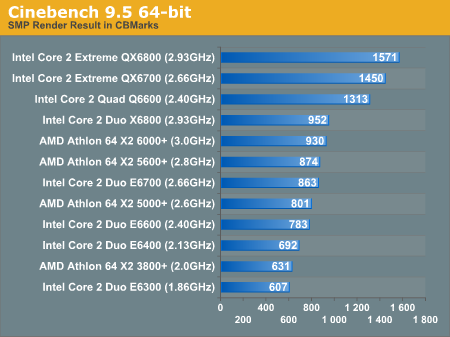Intel Core 2 Extreme QX6800: The Fastest Desktop CPU, now with more cores
by Anand Lal Shimpi on April 9, 2007 12:59 PM EST- Posted in
- CPUs
3D Rendering Performance
We've moved on to using 3dsmax 9, which allows us to run a 64-bit version of the program for our tests. The test scenario is still made up of the CPU rendering tests of the SPECapc 3dsmax benchmark. We report the rendering composite, which is simply the geometric mean of render times across seven benchmarks normalized to a set of reference scores. We ran 3dsmax 9 using its Direct3D driver given the poor state of OpenGL performance under Windows Vista.

Quad-core performance is even more pronounced in 3D rendering applications, with the QX6800 maintaining a 58% performance advantage over its dual core predecessor.
The price war continues with the 6000+ falling in between the E6600 and E6400 in performance, while the 5600+ outperforms both of its competitors.
Lightwave 3D 9.0 is available with 64-bit support, giving us another 64-bit 3D rendering test. We looked at performance under two scenes that ship with the program: Dirty_Building and Record_Player. We measured the time it took to render the scene in seconds, lower numbers are obviously better.


POV-Ray's ray tracing benchmark has been a popular CPU test for quite some time, and we turn to its 64-bit SMP beta to stress the CPUs here today:

Our final 3D benchmark is the 64-bit version of Cinebench 9.5, a fairly popular 3D rendering benchmark due to its ease of use and quick runtimes. We ran the multi-threaded CPU rendering test and reported the final score in CBmarks. Higher numbers are better:











34 Comments
View All Comments
irev210 - Monday, April 9, 2007 - link
You should also put overclocking as a factor.As an enthusiast oriented site, it makes sense to compare the average overclockability of Intel core 2 duo processors against AMD.
Most core 2 duo processors in all forms, can reach at least 3GHz or more, and of course the best can do 3.8GHz or higher.
That is something that AMD can not do, and it should be noted.
You should also evaluate performance per watt as well, as another important deciding factor for us.
rqle - Monday, April 9, 2007 - link
That and also the fact that clock for clock, intel is extremely faster. A 2.6ghz Intel is FASTER than a 3.0ghz X2 AMD, and intel chips can OC much higher.photoguy99 - Monday, April 9, 2007 - link
As usual a good article, kudos.However being AT has many enthusiast followers, would readers not be interested to note that:
1) AMD has near zero headroom for over clocking
2) AMD's chips use more power than Intel at the same performance level. Yes it is not as important as in a data center, but can will still make a small difference in your power bill.
So to conclude, it seems the answer is yes, AMD is competitive on the low end, but why give up these two advantages when the price is so similar?
kmmatney - Monday, April 9, 2007 - link
"1) AMD has near zero headroom for over clocking"Seeing as how so many people are overclocking their AMD chips from 1.8 Ghz to 2.8 GHz, your comment is not true.
yyrkoon - Monday, April 9, 2007 - link
To put it a little differently, with the motherboard I use, a 3600+ and perhaps a couple sticks of Corsair value ram, you can build a 'modern' system, capable of doing anything most users would need to do, for ~$500 including a small LCD monitor. Try doing that with an Intel system, that will keep up with this AMD system, you can not . ..yyrkoon - Monday, April 9, 2007 - link
Simply, because the platform for AMD can be far more inexpencive, with much better features. Platform, of course, meaning the motherboard. Take my ABIT NF-M2 nView for example, find my an intel board, with the same features, for under $150usd, that is as stable. Keep in mind, the NF-M2 nView only runs $90usd. Very stable board, and many features, including Heatpipe passivly cooled chipset(OTES), excellent overclocking features (read my post above, that will blow your 'minimal head room for overclocking' theory out of the water ;) ), 4x SATAII ports, 2x PATA ports, 8x USB ports, 1x firewire port, onboard graphics, onboard GbE, onboard sound, 1x 16x PCIe, 1x 1xPCIe 2x PCI, with 4 dimm slots capable of supporting up to 8GB of DDR2. Also keep in mind, that I have read, people have had the X2 3600+ up to 3Ghz, but of course, this is what I have read, and not personally experienced.Anyhow, the Intel CPUs are great, and I honestly wanted to upgrade to C2D myself, however, after reading loads of posts all over the web, and seeing all the issues with the latest C2D platform boards, and the overall cost for a motherboard that offers as many features as the board I listed above, I did not want to 'break the bank' to do so. Once OEMs come around, with a motherboard sporting a modern chipset for C2D, plenty of features, and offer SLI, or single GPU variations, Intel could THEN in my eyes, be compedetive. Not everyone needs or even wants SLI, or a lot of the other garbade OEMs are putting on their 'top of the line' motherboard, increasing the prices dramatically.
dm - Monday, April 9, 2007 - link
Not necessarily. Due to the fact that Intel is still using discrete memory controllers, there are a lot of motherboards out there that can take advantage of this. Take a look for example, an Asus P5PE-VM (http://www.asus.com/products4.aspx?l1=3&l2=11&...">http://www.asus.com/products4.aspx?l1=3...l3=272&a... which can be a great upgrade for those who have AGP and DDR1 components but wanting to experience the power of Conroe. An Intel® Core™ 2 Duo E4300 processor is a perfect match for this. The i865 chipset is a stable and has proven itself for quite some time already, and this motherboard goes for under $60!!!
And there's also a flavor where PCIe and AGP, DDR2 and DDR1 are acceptable, look at the ASrock 775Dual-VSTA (http://www.asrock.com/mb/overview.asp?Model=775Dua...">http://www.asrock.com/mb/overview.asp?Model=775Dua..., giving users flexibility for users to either use DDR1 with PCIe, or DDR2 with AGP.
yyrkoon - Tuesday, April 10, 2007 - link
I would not put an Asrock board in your system, let alone one of mine ever again. Again, I have looked, and looked long, and hard, for a motherboard, with as many features, as the one I use currently, and there is simply *none* in the same class as this board, period. Motherboards that have the features I want, using any Intel capable chipset, and 100% rock solid stability simply do not exist, in this price range. If I had the money, I would probably end up spending $300-$400 usd for a good Intel board, and you can bet, it would not be an Asus board either. Anyhow, the current motherboard I own, only has one issue, and one that is not really that big of an issue (it will not POST, or boot Windows, while a USB HDD is powered on, and attached to one of its USB ports).ABIT, MSI, Gigabyte, Tyan(Foxconn seems to be ok, and Intel boards now days, seem to be hit and miss, unless you go with a server board), are pretty much the only system board manufactuers I will use in any system in the future, and this is subject to change as whomever starts making bad parts.
photoguy99 - Monday, April 9, 2007 - link
Since the article included the quote below, it might be more informative to note that QuickTime can only use two threads at a time, which explains why AMD looked better in this test:"The Quicktime H.264 test paints a particularly good picture for AMD, with the 6000+ equalling even the Q6600."
yacoub - Monday, April 9, 2007 - link
And so starting with this test all benchmark numbers from Anandtech from here on out become that much less relevant to the vast majority of your readership because they still run WinXP 32bit - and have little reason to upgrade their OS to Vista yet. :[
Maybe in a year or two your reviews conducted on Vista 64bit will be more relevant to the majority of your readership, as by then driver support will be much improved, games will be Vista/DX10 focused, and overall performance on Vista will be that much better than WinXP and thus create an incentive for WinXP users to finally make the switch.
Until then, thanks for the less relevant benchmark results...